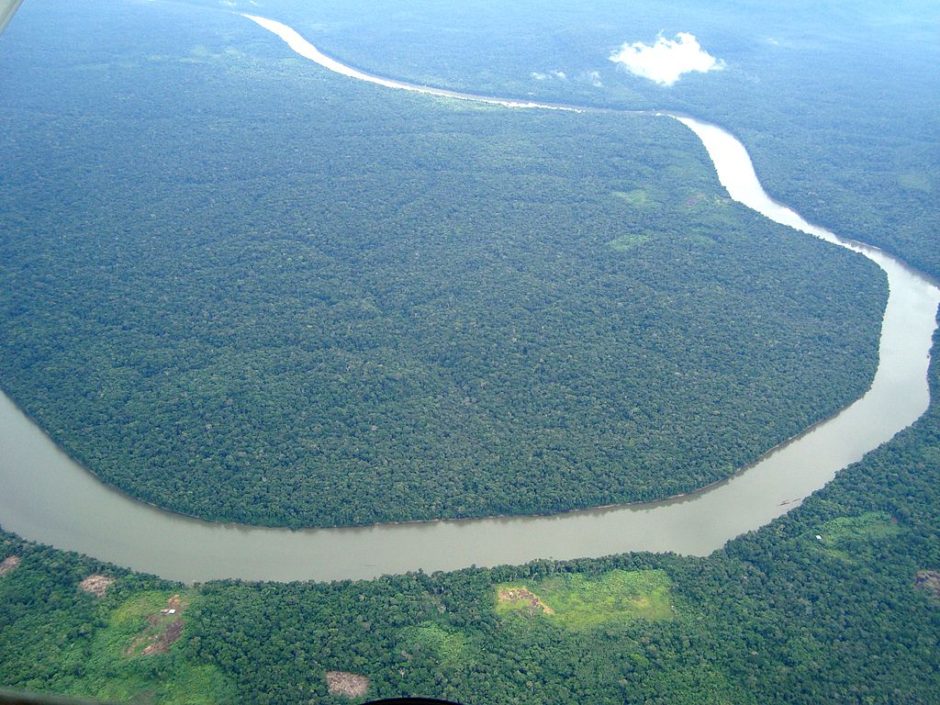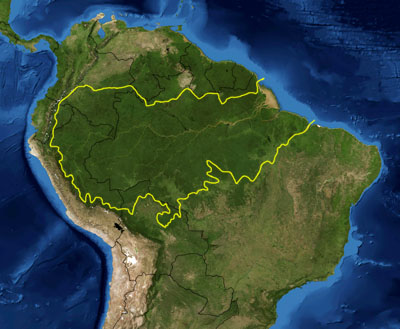
Fulfilling a childhood dream, I finally made it to the Amazon rainforest, a vast, trackless, virtually unspoiled region in Brazil. Bisected by rivers and streams and speckled with lakes, it’s a gigantic greenhouse of unimaginable richness and diversity, containing one-tenth of the world’s plants and animal species.
Comprising 36 percent of Brazil’s territory, the Amazon is one of the world’ finest eco-tourism destinations. Yet until about two decades ago, the Brazilian government did not bother to market it seriously. Facilities were primitive and travellers were afraid of contracting a host of tropical diseases.
But times have changed.
Jungle lodges have sprung up and a regimen of vaccinations can keep maladies like malaria and yellow fever at bay.
The best time to visit the Amazon is in the late spring and early summer, when the rainy season has ended. In May and June, when water levels peak, the remotest areas of the rainforest — the fabled igarapes, the narrow, vine-choked channels that cut deep into the forest — can be penetrated by canoe, the transportation of choice in these wild parts.
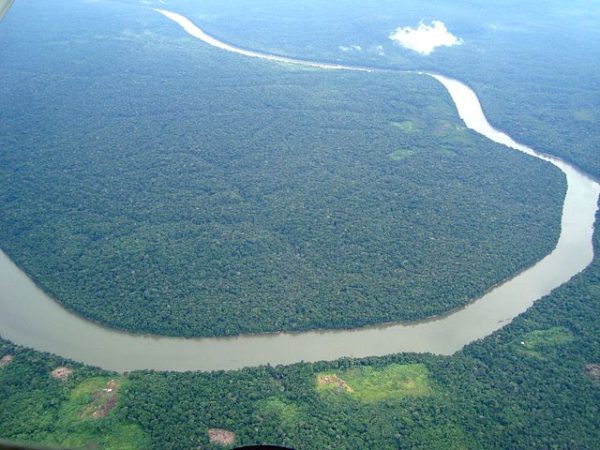
The igarapes are reached via the Amazon River and its 1,100 tributaries, ranging from the Rio Negro to the Rio Branco. Fed by torrential downpours and the snowmelt of the Andes mountains, these rivers are remarkably wide and deep and can accommodate ocean-going vessels. The Amazon River and its tributaries, which offer 80,000 kilometers of navigable waterways, drain Brazil and neighboring countries into which the Amazon forest extends.
The best way of exploring it is from the comfort and safety of a lodge. During my 10-day trip, I stayed in three lodges: Guanavenas, 300 kilometres east of Manaus, the biggest city in the Amazon; the Jungle Palace, 30 kilometres west of Manaus, and Lago Salvador, eight kilometers north from Manaus.
Accessible only by boat via the Rio Urubu, a tributary of the Amazon River, Guanavenas sits on the bluff of a small, densely-wooded island next to the somnolent village of Silves.
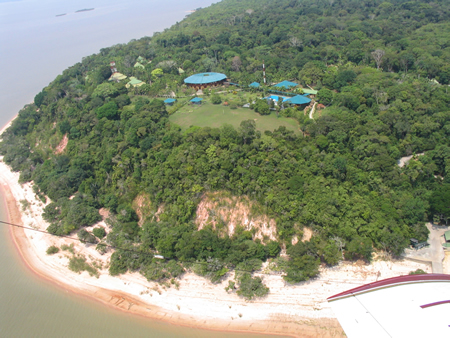
Looking uncannily like a well-tended kibbutz, with its neat cottages, manicured lawns, blazing flower beds, tidy paths, communal dining room and swimming pool, Guanavenas has all the amenities of a first-class resort.
Packages of two to four nights enable a visitor to enjoy the natural wonders of the rainforest, whose primary colors are green for the forest, blue for the sky, black for the Rio Negro and muddy yellow for the Amazon River.
Days and nights at Guanavenas are rigidly structured. The four hour morning program begins at 8 a.m. after a hearty regional breakfast. The two-and-a-half hour afternoon program starts at 3:30 p.m., following lunch and a siesta.
As I discovered, the rainforest is a tangled, impenetrable mass of trees, bushes, shrubs and flowers. There are 2,500 kinds of trees in the jungle, from hardwoods that tower majestically over the canopy to a dizzying array of palms. Hardwoods are shaped into fine furniture and tree resins are used to make pharmaceuticals and perfume.

Although an alarming proportion of the rainforest already has been destroyed by loggers and farmers, much of it still remains untouched and intact, as I found out during a guided walk.
The leaf-encrusted floor of the forest is thick with 60,000 types of plants, ferns and flowers of various sizes and hues. Tropical fruits such as the tapereba and the gaviola yield delicious, though watery, juices.
As we passed beneath magnificent hardwoods and brushed past dense foliage, I did not see a single wild beast. The jungle teems with some 300 mammals, from jaguars to monkeys, but they generally avoid contact with human intruders, emerging only at night after the heat of the day has subsided.
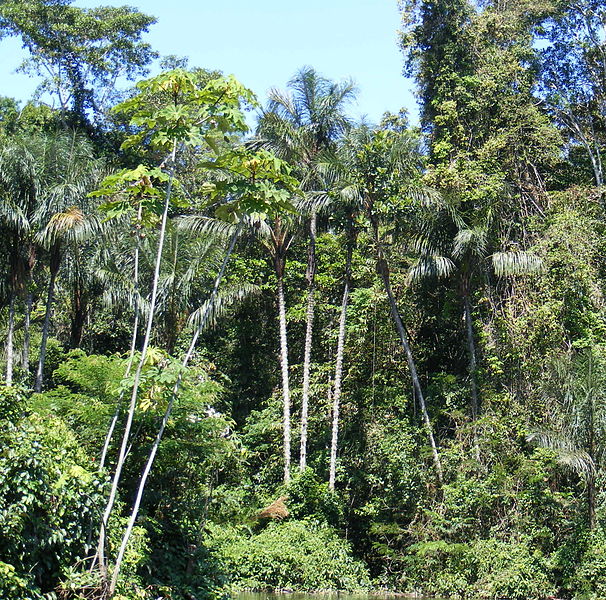
The insects in the forest run the gamut from the carnivorous black ant that feeds on rodents to the hairy tarantula spider that’s as big as a land crab.
There are an awesome variety of snakes, from the boa constrictor to the poisonous bushmaster, but unless you disturb their lairs or accidentally brush one off a branch, you need not fear bumping into a snake.
The 2,000 variety of birds range from the beautifully plumaged macaw to the noisy parrot.
There are 2,000 species of fish, included the dreaded red-bellied piranha, a compact-sized specimen with razor-sharp teeth and voracious eating habits. In search of the piranha, my guide and I set off for an igapos, the flooded forests that are the preserve of the piranhas, in a canoe.
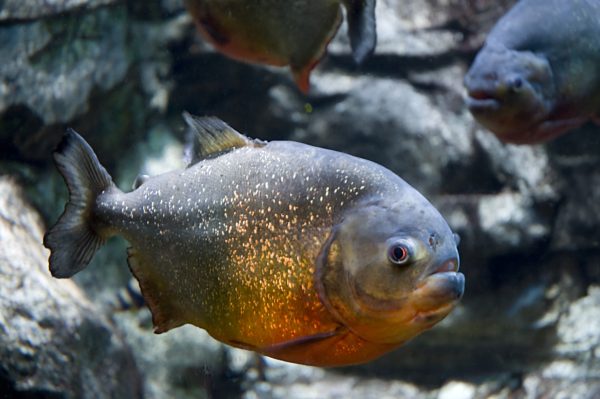
The guide snagged three wriggling piranhas, their oil scales glinting in the sun. For show, he inserted a hard brown reed into one of its mouths. The piranha snapped off a piece before being thrown back into the lukewarm water.
The following night, we piled into a canoe to look for caimans, the shorter Brazilian cousin of the American alligator.
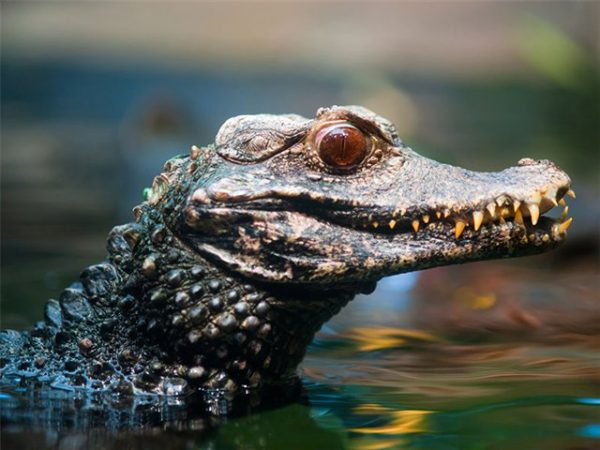
The guide spotted a caiman by shining a flashlight into its fiery orange eyes. He tossed a line into the murky water and landed one with ease. Thrashing around wildly, the three-foot baby caiman soon calmed down. No longer intimidated by its presence, I ran my fingers over its leathery backside and delicate webbed feet.
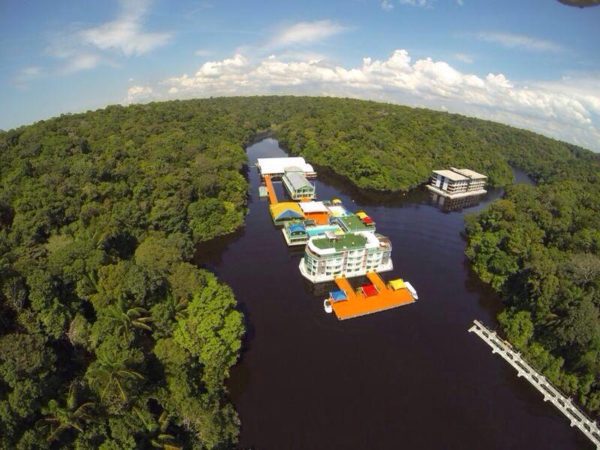
The Jungle Palace, which rests on a barge on the Rio Negro, is another jumping-off point for excursions into the jungle. In a sun-lit clearing, a guide held forth on medicinal botany. Picking up an unidentified red fruit from a bush, he told us that indigenous people nibble on it to cure ear aches.
Wielding a fishing rod, he lassoed an electric eel from a shady creek. He was careful not to touch it, but a reckless tourist who disregarded his advice was jolted by a current of electricity.
Standing under a canopy of palm trees during a pelting rain storm, the guide demonstrated his skill as a woodsman. Deftly shredding a few palm leaves with his knife, he fashioned the strands into an elegant bird and an elaborate flower.
One night, the guide rowed the canoe into a narrow channel. And there, under a magical starry sky, we heard the mating call of a colony of frogs, sounding like the clatter of a thousand teacups.
Lago Salvador, just minutes by speedboat from Manaus, might as well have been hundreds of kilometers away from the bustling city. Nestled in the folds of a rainforest overlooking a glassy lake, Laga Salvador was a study in intense solitude and serene beauty.
After giving me a quick tour of the grounds, my guide dropped me off at one of the four lake-side cottages where I would spend the night in solitary seclusion. Since I was the only guest on the grounds, I admit I was somewhat apprehensive after he had left. Would a jaguar crash through the mesh window and devour me in a few gulps?
I was indulging in paranoia, of course, but that scary moment soon passed.
As I contentedly nodded off to sleep a few hours later to the insistent hum of crickets in the distance, I felt a calm descending on me and was supremely glad I had seen the Amazon rainforest in all its glorious dimensions.
